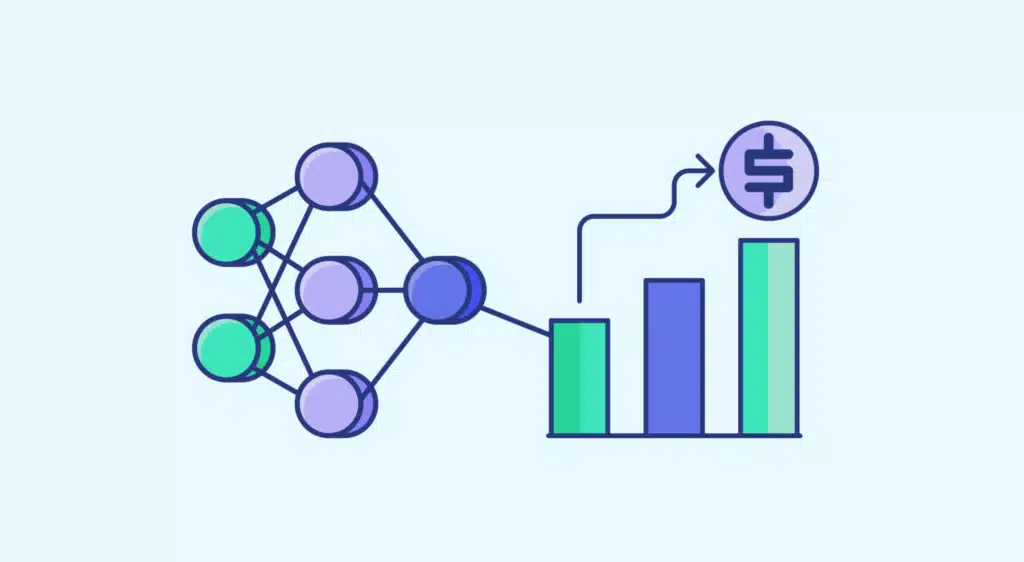Data Science is shaking up the world of finance. Find out how data science is being used by this sector, and how to become a financial Data Scientist to combine the best of both world: Data Science and Finance
Thanks to Data Science, the finance industry is undergoing a veritable upheaval. By analyzing data, companies can extract valuable information using mathematical and statistical techniques.
A wide variety of methods and software tools are used by financial organizations and institutions. Using data, they can better calculate risks, detect fraud, limit losses and maximize profits.
While data science is now used in all sectors, financial institutions are among the pioneers. This industry was one of the first to turn to data analysis.
What is Data Science and what has Data Science and Finance to do together?
Before going into more detail about its role in finance, a quick reminder is in order about what Data Science is. It is a discipline that brings together methods, scientific processes, systems and algorithms for extracting knowledge from structured or unstructured data.
Put simply, Data Science involves collecting data from a variety of sources to extract actionable information. Sources can be customer databases, for example, but also new digital technologies such as mobile applications, social networks or e-commerce stores.
This data is used to make data-driven decisions. In particular, it is possible to predict future consumer behavior, discover a company’s weaknesses or spot the competition’s strengths.
Risk analysis
Risk Analytics enables finance companies to measure risks before making decisions. Based on data, it is possible to measure the severity and frequency of hazards.
The risks in question may come from the market, from credit, or even from competitors. The first step is to identify risks, then monitor and prioritize them.

A company can use data such as financial transactions or customer information to create a “score” model and optimize costs. In particular, risk analysis is used to check a customer’s reliability before granting credit, by applying Machine Learning algorithms to the transactions he makes.
A financial company needs to anticipate the behavior of each customer. Data Science makes it possible to make predictions based on past behavior. In particular, it’s possible to divide customers into “clusters” and predict how much money each will earn in the future.
Using Data Science and Machine Learning techniques, customers can be separated into different categories based on attributes such as age, employment or address. By creating predictive models, it is then possible to decide which of these characteristics are most important.
Fraud detection
Fraud is a major problem for financial firms. As the number of transactions increases, so does the risk. Fortunately, data analysis makes it possible to detect attempted fraud.
One of the most widespread practices is credit card fraud. Algorithms are now available to accurately detect any anomaly. These systems can also detect excessive purchases and restrict accounts accordingly.
Algorithmic trading
Big Data and Data Science have had a major impact on algorithmic trading. Data streams are analyzed to make better decisions.
This helps to better choose which stocks to invest in, when to buy them and when to sell them. This is a valuable asset for the world of finance.
Personalization and customization
Increasing customer interaction through personalization has become essential for finance companies. Data Science makes it possible to examine customers’ digital experience and adjust it to meet their wants and needs.
AI is making great strides in understanding human language and emotions. This enables a high level of personalization. Data Engineers can create models to analyze customers’ actions and discover the circumstances in which they need financial advice.
Customer data management
The structure and volume of financial data can vary greatly. It can range from transaction information to data from social networks or smartphone applications.
This data is not always structured. Machine Learning is proving invaluable in extracting information from data. AI tools such as natural language processing, text analysis and data mining are particularly useful.
Predictive analysis
Data analysis enables financial institutions and organizations to predict future events from data. By analyzing social networks, news articles and other sources of information, it is possible to predict costs, major events or stock market movements.
This approach also helps to determine how best to intervene. Predictive analytics therefore occupies a major place within these organizations.
Decision-making
Traders, financial executives and shareholders need to analyze the market on a daily basis and make strategic decisions. Data Science helps optimize these decisions.
Using past and present data, it becomes possible to determine the viability of trading. The most volatile markets can be identified with greater precision.
As a result, CFOs can develop a profitable investment portfolio. Some analytical platforms even indicate when to invest and when to sell assets.

What role does Data Science and finance play together?
Given the many possibilities offered by Data Science for the world of finance, Data Scientists are highly sought-after in this sector. These experts now occupy a crucial position.
The immense volume of data collected by the finance industry represents a real challenge. One of the biggest difficulties is getting the most out of unstructured data.
What’s more, the world of finance is a complex one. Mergers and acquisitions, complex product offerings and ever-changing laws represent additional difficulties for data scientists compared to other sectors.
Financial Data Scientists are experts with both technical skills and in-depth industry knowledge. For example, they are able to use Data Science techniques to detect fraud attempts or create personalized experiences.
Likewise, these professionals can create complex data warehouses or create algorithms to automate important transactions. That’s why financial Data Scientists are highly sought-after, and can earn handsome salaries.
What does a financial data scientist in Data Science and Finance do?
A financial Data Scientist can have a wide variety of missions. On a day-to-day basis, they may be involved in risk management, fraud detection, customer experience personalization, customer analytics, algorithmic trading or pricing automation.
Generally speaking, the role of the Data Scientist is to develop processes for collecting, storing and analyzing data to derive insights. Based on this information, they propose strategic solutions to business problems.
The Financial Data Scientist collects strategic data, and brings cohesion to it using Data Modeling techniques. They use Natural Language Processing and Computer Vision to analyze unstructured data.
Working with the various teams, he identifies problems and proposes data-driven solutions. Quantitative analysis provides information from which to develop comprehensive solutions.
In addition, the Financial Data Scientist trains Machine Learning models on data and tests new approaches via system prototypes. They also code new algorithms to facilitate data analysis and Machine Learning.
This professional applies new approaches to risk analysis, or looks for new ways to automate risk management processes. They may also design identity verification applications to protect the company against fraud attempts.
By analyzing product usage and customer behavior, they can suggest ways of improving the user experience. Finally, the Financial Data Scientist can monitor the performance of trading algorithms and modify them for better results.
In the event of a financial crisis or recession, the Data Scientist plays a key role in decision-making. His or her services are particularly in demand in these critical situations, as data analysis helps identify how to cut costs and gain efficiency.
Financial Data Scientist vs. Data Scientist: what are the differences?
Data Scientists must possess three main skills: knowledge of their field of activity, technological skills, and mastery of mathematics and statistics. Depending on the industry, the importance of each of these skills varies.
Most Data Scientists are more proficient in business and statistics than in technology, except in the science and education sectors. In finance, the majority of Data Scientists are researchers. At the same time, half of them identify themselves as Business Data professionals.
Although highly sought-after, Data Scientists are rarer in finance than in other industries. The majority work in commerce, professional services and communications. Only 11% of data scientists work in the finance industry.
What skills does a Financial Data Scientist need?
To become a financial Data Scientist, you’ll need experience and skills. You can start out as a Data Analyst, then move up the ladder to specialize.
Most Data Scientists have technical skills in probability and statistics, data visualization, machine learning, Python and SQL.
However, a financial Data Scientist must also have domain expertise and communication skills.
A Data Scientist in the finance sector needs to have a degree in mathematics, statistics or computer science. Of course, he or she must also be familiar with finance and the laws that govern it.

The financial Data Scientist needs to be familiar with the type of data he or she will be analyzing. Depending on whether he’s working for an investment fund, a bank or a fintech company, he won’t be dealing with the same data.
For example, a Data Scientist wishing to analyze investment risk data needs to understand economics, financial markets, portfolio management and risk analysis.
He or she must also handle a wide variety of general Data Science tools, such as Machine Learning algorithms or Big Data frameworks. This expert must also know how to create statistical models.
Big Data technologies such as Apache Spark and Hadoop should hold no secrets for him/her. They are also able to handle different programming languages such as Python, R, JavaScript and C++, depending on their chosen specialization.
The Financial Data Scientist is able to understand and work with both structured and unstructured data sets. They also understand the main systems used in the finance industry, such as SAP, Oracle and SWIFT.
In terms of communication, the Financial Data Scientist must be able to lead the troops and convince the organization’s decision-makers of the benefits of Data Science. He or she must also be understood by the company’s executives, managers and other non-technical profiles.
How much does a Financial Data Scientist earn?
A Data Scientist’s salary varies not only according to experience, but also to the company he or she works for and the sector in which it operates. According to PayScale, a Financial Data Analyst in the USA can earn around $70,000 a year. A Quantitative or Quant Analyst earns an average of $85,000 a year.
Financial Data Scientists can expect even higher salaries. Still according to PayScale, a generalist Data Scientist earns $96,000 a year. Financial specialists can negotiate to earn more.
In France, according to Glassdoor, a Data Scientist earns around €45,000 a year. According to our own survey of CAC40 companies, their salary can range from €35,000 to €55,000 a year. After three years’ experience, the average salary exceeds €55,000 per year.cientist financier ?
How can I train to become a Data Scientist and work both in Data Science and Finance?
To become a financial Data Scientist, DataScientest is the place to be. Our Data Scientist pathway enables you to acquire all the necessary technical skills. This option is ideal if you already have some knowledge of the world of finance.
The various modules of the program cover the different aspects of data science. You’ll learn Python programming, data visualization, Machine Learning, Deep Learning and Big Data analysis.
The course is entirely distance learning, with 85% individual coaching on our Cloud platform and 15% MasterClass. You can choose between Continuing Education or Intensive BootCamp, depending on how much free time you have.
At the end of the course, you will receive a certificate issued by MINES ParisTech / PSL Executive Education thanks to a partnership. 93% of our alumni have found a job immediately after the course.
As for financing, this course is eligible for funding options. Don’t wait any longer and discover the DataScientest training course!










